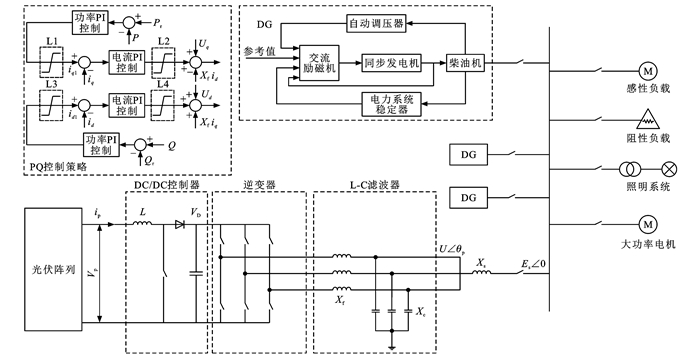Stability of ship grid-connected photovoltaic power system
-
摘要: 为分析高渗透率光伏并网导致船舶电力系统等效转动惯量降低,静态和暂态稳定性恶化的问题,以中国首艘集成并网光伏电力系统的“中远腾飞”轮汽车滚装运输船为研究对象,根据船舶电力负荷计算书和电气系统图建立了船舶并网光伏电力系统仿真模型;光伏并网逆变器采用恒功率控制策略,对比了牛顿-拉夫逊、XB快速解耦、BX快速解耦、龙格-库塔、Iwanoto和简单鲁棒算法在系统潮流分析中的效果差异;对比了8组仿真算例,研究了不同光伏渗透率下系统的静态稳定性,分析了光伏并网运行中连续负载和艏侧推器顺次启动过程对系统暂态稳定性的影响。分析结果表明:牛顿-拉夫逊法的迭代次数仅为4次,动态仿真时长仅为Iwanoto算法的10.4%,其他6项评估参数与多种算法结果均值一致,在6种方法中最适于计算强耦合刚性电力系统潮流;随着光伏渗透率的提升,其系统的总有功和无功功率损失呈增长趋势,尤其当渗透率超过33.36%时,无功功率损失是有功功率损失的10倍;21.32%渗透率下,与同步发电机组相同功率等级的动力负载启动将导致船舶电力系统同时出现暂态功角和电压失稳;并网型光伏系统能够快速补偿船舶电力系统的低频振荡,但不能在维持或恢复船舶电力系统暂态稳定过程中起到有效作用。Abstract: To analysis the problems of equivalent inertia moment reduction, static and transient stabilities deterioration when a high-penetration grid-connected photovoltaic system was integrated into the ship power system, the first vehicle carrier transport ship ("COSCO Tengfei") integrated the grid-connected photovoltaic power system manufactured in China was taken as the research object. The simulation model of ship grid-connected photovoltaic power system was established according to the power load calculation and electrical system diagram of ship. A constant power control strategy was adopted for the photovoltaic grid-connected inverter, the differences in the calculation results of Newton-Raphson, XB fast decoupled, BX fast decoupled, Runge-Kutta, Iwanoto, and simple robust algorithm were discussed in terms of the system power flow analysis. A total of eight simulation examples were analyzed to discuss the static stability of system under different photovoltaic penetrations. The effects of continuous load and sequential launching of bow thruster on the transient stability of system were analysis during the photovoltaic grid-connected operation. Analysis results show that the Newton-Raphson method requires four iterations, the dynamic simulation time is only 10.4% of that needed by the Iwanoto algorithm, and the other six evaluation parameters for the Newton-Raphson method are consistent with the average results of various algorithms. So, the Newton-Raphson algorithm is the most suitable method to solve the power flows of strongly coupled rigid power systems. The total active and reactive system power losses increase as the photovoltaic penetration increases. Especially when the photovoltaic penetration exceeds 33.36%, the reactive power loss is 10 times the active power loss. When the dynamic load of the same magnitude as the power provided by the synchronous generator set is launched at a penetration of 21.32%, the transient power angle and voltage instability occur in the ship power system simultaneously. The grid-connected photovoltaic system can quickly compensate for the low-frequency oscillation in the ship power system, but it cannot play an effective role in maintaining or restoring the ship power system transient stability. 4 tabs, 10 figs, 30 refs.
-
表 1 柴油同步发电机组主要参数
Table 1. Main parameters of diesel synchronous generator set
编号 视在功率/MVA 额定电压/kV 额定转速/(r·min-1) 功率因数/% 电阻/Ω 阻抗比 时间常数/s DG1 0.925 0.440 1 800 80 1.970 0.19 0.013 7 DG2 1.200 0.440 1 800 80 1.130 0.10 0.026 5 DG3 1.200 0.440 1 800 80 1.130 0.10 0.026 5 表 2 等效电气负载主要参数
Table 2. Main parameters of equivalent electrical loads
名称 有功功率/kW 视在功率/kVA 额定电压/kV 额定电流/A 功率因数/% 侧推电机负载 600 667.7 0.44 872.36 92.53 应急负载 500 580.8 0.44 762.11 92.20 风机类负载 120 151.4 0.44 173.61 92.37 泵类负载 1 030 1 117.6 0.44 1 285.72 92.89 表 3 算例结果差异性分析
Table 3. Difference analysis of example results
潮流计算方法 牛顿-拉夫逊法 XB快速解耦 BX快速解耦 龙格-库塔 Iwanoto 简单鲁棒算法 迭代次数 4 4 4 13 21 4 潮流仿真时间/s 0.054 0.040 0.087 0.215 0.261 0.049 动态仿真时间/s 38.899 39.506 39.286 50.179 373.657 39.484 最大有功功率差异标幺值 1.114 7 1.114 7 1.114 7 0.000 5 0.233 6 1.114 7 最大无功功率差异标幺值 0.608 0 0.608 0 0.608 0 0.000 8 0.276 3 0.608 0 Bus9电压标幺值 0.969 2 0.969 2 0.969 2 0.000 7 0.208 1 0.969 2 Bus9相位/rad -0.081 6 -0.081 6 -0.081 6 45.732 3 1 348.885 6 -0.081 6 DG3转子角标幺值 1.342 9 1.342 9 1.342 9 100.936 6 3 018.803 0 1.342 9 DG3转速标幺值 1.000 0 1.000 0 1.000 0 1.231 6 2.5039 1.000 0 表 4 并网光伏电力系统的输出功率和连接母线电压相位
Table 4. Output powers of grid-connected photovoltaic power system and connecting bus voltage phases
算例编号 并网光伏电力系统有功功率标幺值 并网光伏电力系统无功功率标幺值 Bus2的电压相角/rad 1 0.08 0.106 8 -0.003 8 2 0.16 0.099 4 0.003 6 3 0.24 0.092 6 0.011 1 4 0.32 0.086 5 0.018 6 5 0.40 0.080 9 0.026 1 6 0.48 0.076 0 0.033 6 7 0.56 0.071 6 0.041 0 8 0.64 0.068 8 0.048 5 -
[1] 严新平. 新能源在船舶上的应用进展及展望[J]. 船海工程, 2010, 39(6): 111-115, 120. doi: 10.3963/j.issn.1671-7953.2010.06.031YAN Xin-ping. Progress review of new energy application in ship[J]. Ship and Ocean Engineering, 2010, 39(6): 111-115, 120. (in Chinese) doi: 10.3963/j.issn.1671-7953.2010.06.031 [2] REN Jing-zheng, LVTZEN M. Selection of sustainable alternative energy source for shipping: multi-criteria decision making under incomplete information[J]. Renewable and Sustainable Energy Reviews, 2017, 74: 1003-1019. doi: 10.1016/j.rser.2017.03.057 [3] DONG Jun, FENG Tian-tian, YANG Yi-sheng, et al. Maro-site selection of wind/solar hybrid power station based on ELECTRE-Ⅱ[J]. Renewable and Sustainable Energy Reviews, 2014, 35: 194-204. doi: 10.1016/j.rser.2014.04.005 [4] BILGILI L, CELEBI U B. Developing a new green ship approach for flue gas emission estimation of bulk carriers[J]. Measurement, 2018, 120: 121-127. doi: 10.1016/j.measurement.2018.02.002 [5] 严新平, 孙玉伟, 袁成清. 太阳能船舶技术应用现状及展望[J]. 船海工程, 2016, 45(1): 50-54, 60. doi: 10.3963/j.issn.1671-7953.2016.01.011YAN Xin-ping, SUN Yu-wei, YUAN Cheng-qing. Review on the application progress of solar ship technology[J]. Ship and Ocean Engineering, 2016, 45(1): 50-54, 60. (in Chinese) doi: 10.3963/j.issn.1671-7953.2016.01.011 [6] SUN Yu-wei, YAN Xin-ping, YUAN Cheng-qing, et al. The application of hybrid photovoltaic system on the ocean-going ship: engineering practice and experimental research[J]. Journal of Marine Engineering and Technology, 2019, 18(1): 56-66. doi: 10.1080/20464177.2018.1493025 [7] LAN Hai, WEN Shu-li, HONG Ying-yi, et al. Optimal sizing of hybrid PV/diesel/battery in ship power system[J]. Applied Energy, 2015, 158: 26-34. doi: 10.1016/j.apenergy.2015.08.031 [8] PARK A, LAPPAS P. Evaluating demand charge reduction for commercial-scale solar PV coupled with battery storage[J]. Renewable Energy, 2017, 108: 523-532. doi: 10.1016/j.renene.2017.02.060 [9] KARATUĞ Ģ, DURMUSOĞLU Y. Design of a solar photovoltaic system for a Ro-Ro ship and estimation of performance analysis: a case study[J]. Solar Energy, 2020, 207: 1259-1268. doi: 10.1016/j.solener.2020.07.037 [10] 刘颖, 秦文萍, 王磊, 等. 可减少光伏弃光量的低压配电网并网逆变器电压控制策略[J]. 太阳能学报, 2020, 41(8): 151-159. https://www.cnki.com.cn/Article/CJFDTOTAL-TYLX202008021.htmLIU Ying, QIN Wen-ping, WANG Lei, et al. Voltage control strategy of PV grid-connected inverter in low voltage distribution network with reduction amount of light discarded[J]. Acta Energiae Solaris Sinica, 2020, 41(8): 151-159. (in Chinese) https://www.cnki.com.cn/Article/CJFDTOTAL-TYLX202008021.htm [11] WEN Shu-li, LAN Hai, HONG Ying-yi, et al. Allocation of ESS by interval optimization method considering impact of ship swinging on hybrid PV/diesel ship power system[J]. Applied Energy, 2016, 175: 158-167. doi: 10.1016/j.apenergy.2016.05.003 [12] YIN Xiu-xing, ZHAO Xiao-wei, ZHANG Wen-can. A novel hydro-kite like energy converter for harnessing both ocean wave and current energy[J]. Energy, 2018, 158: 1204-1212. doi: 10.1016/j.energy.2018.03.121 [13] RAHMAN M S, MAHMUD M A, POTA H R, et al. A multi-agent approach for enhancing transient stability of smart grids[J]. International Journal of Electrical Power and Energy Systems, 2015, 67: 488-500. doi: 10.1016/j.ijepes.2014.12.038 [14] LI Ming, ZHANG Xing, GUO Zi-xuan, et al. The dual- mode combined control strategy for centralized photovoltaic grid-connected inverters based on double-split transformers[J]. IEEE Transactions on Industrial Electronics, 2020, 68(12): 12322-12330. [15] KUMAR S R, GAFARO F, DAKA A, et al. Modelling and analysis of grid integration for high shares of solar PV in small isolated systems: a case of Kiribati[J]. Renewable Energy, 2017, 108: 589-597. doi: 10.1016/j.renene.2017.02.084 [16] SEPASI S, REIHANI E, HOWLADER A M, et al. Very short term load forecasting of a distribution system with high PV penetration[J]. Renewable Energy, 2017, 106: 142-148. doi: 10.1016/j.renene.2017.01.019 [17] GUPTA N, GARG R, KUMAR P. Sensitivity and reliability models of a PV system connected to grid[J]. Renewable and Sustainable Energy Reviews, 2017, 69: 188-196. doi: 10.1016/j.rser.2016.11.031 [18] ZHANG Qian-jin, MAO Ming-xuan, GUO Ke, et al. Stability problems of photovoltaic (PV) inverter in weak grid: a review[J]. IET Power Electronics, 2020, 13(11): 2165-2174. doi: 10.1049/iet-pel.2019.1049 [19] 马铭遥, 熊鹏博, 孟雪松, 等. 基于光伏并网逆变器直流过压故障的暂态分析及故障成因定位[J]. 高电压技术, 2021, 47(1): 187-197. https://www.cnki.com.cn/Article/CJFDTOTAL-GDYJ202101020.htmMA Ming-yao, XIONG Peng-bo, MENG Xue-song, et al. Transient analysis and fault cause location of DC overvoltage fault based on photovoltaic grid connected inverter[J]. High Voltage Engineering, 2021, 47(1): 187-197. (in Chinese) https://www.cnki.com.cn/Article/CJFDTOTAL-GDYJ202101020.htm [20] TILL A, YOU Shu-tang, LIU Yi-lu. Impact of high PV penetration on transient stability—a case study on the U.S. ERCOT system[J]. Renewable Energy and Power Quality Journal, 2020, 18: 345-350. doi: 10.24084/repqj18.325 [21] 万千, 夏成军, 管霖, 等. 含高渗透率分布式电源的独立微网的稳定性研究综述[J]. 电网技术, 2019, 43(2): 598-612. https://www.cnki.com.cn/Article/CJFDTOTAL-DWJS201902030.htmWAN Qian, XIA Cheng-jun, GUAN Lin, et al. Review on stability of isolated microgrid with highly penetrated distributed generations[J]. Power System Technology, 2019, 43(2): 598-612. (in Chinese) https://www.cnki.com.cn/Article/CJFDTOTAL-DWJS201902030.htm [22] BALDI F, AHLGREN F, MELINO F, et al. Optimal load allocation of complex ship power plants[J]. Energy Conversion and Management, 2016, 124: 344-356. doi: 10.1016/j.enconman.2016.07.009 [23] NASSAR M E, SALAMA M M A. A novel branch-based power flow algorithm for islanded AC microgrids[J]. Electric Power Systems Research, 2017, 146: 51-62. doi: 10.1016/j.epsr.2017.01.019 [24] KAMH M Z, IRAVANI R. A unified three-phase power flow analysis model for electronically coupled distributed energy resources[J]. IEEE Transactions on Power Delivery, 2011, 26(2): 899-909. doi: 10.1109/TPWRD.2010.2094627 [25] 王博, 路俊海, 郭小江, 等. 多VSC型换流器电力系统潮流计算方法研究[J]. 电网技术, 2016, 40(8): 2344-2349. https://www.cnki.com.cn/Article/CJFDTOTAL-DWJS201608017.htmWANG Bo, LU Jun-hai, GUO Xiao-jiang, et al. Load flow analysis for power system with multi-VSC based converter[J]. Power System Technology, 2016, 40(8): 2344-2349. (in Chinese) https://www.cnki.com.cn/Article/CJFDTOTAL-DWJS201608017.htm [26] HE Guo-qing, XU Xiao-yan, HUANG Yue-hui, et al. Impact on stability of isolated grid of different control strategies of large photovoltaic station[J]. Power System Technology, 2009, 33(15): 20-25. [27] 庄慧敏, 巨辉, 肖建. 高渗透率逆变型分布式发电对电力系统暂态稳定和电压稳定的影响[J]. 电力系统保护与控制, 2014, 42(17): 84-89. https://www.cnki.com.cn/Article/CJFDTOTAL-JDQW201417014.htmZHUANG Hui-min, JU Hui, XIAO Jian. Impacts of inverter interfaced distributed generations with high penetration level on power system transient and voltage stability[J]. Power System Protection and Control, 2014, 42(17): 84-89. (in Chinese) https://www.cnki.com.cn/Article/CJFDTOTAL-JDQW201417014.htm [28] QIU Yuan-chao, YUAN Cheng-qing, SUN Yu-wei, et al. Power quality analysis for ship-photovoltaic power system: a case study[J]. Electrical Power Components and System, 2018, 46(11/12): 1375-1386. [29] QIU Yuan-chao, YUAN Cheng-qing, TANG Jin-rui. Integrating SCESS into a ship-PV power system to mitigate power fluctuations and improve LVRT capability[J]. Arabian Journal for Science and Engineering, 2019, 44: 6769-6781. doi: 10.1007/s13369-018-3623-2 [30] YILMAZ S, DINCER F. Optimal design of hybrid PV-diesel- battery systems for isolated lands: a case study for Kilis, Turkey[J]. Renewable and Sustainable Energy Reviews, 2017, 77: 344-352. doi: 10.1016/j.rser.2017.04.037 -





 下载:
下载:











